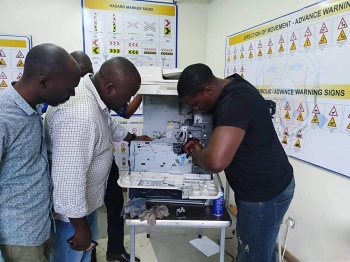CTVSD2/Introduction/Methods
There are variety of methods available to support competency-based assessments. For online and e-assessments video and image capture based observations, skills tests, simulations, e-portfolios have proven to be effective.
Combining methods of assessment
When developing integrated assessments, it may not always be possible to combine elements into cohesive groups. Alternative approaches are:
- to select forms of assessment for each of the elements and then try to combine them;
- the common elements may be integrated, and a search then made for appropriate methods of assessment.
It is unlikely, whichever approach is adopted, that professional competency can be assessed using only one method of assessment. For some elements performance criteria it may not be possible to devise or implement integrated forms of assessment. These require a combination of assessment methods, which could consist of a written examination covering basic fundamental knowledge, a period of practical experience, and a practical and demonstration directly observed or videoed.
Where integrated assessments are not possible, the suggested strategy is that they must be replaced by a combination of methods which assess the problem solving, practical skills and attitudinal factors required.
Examining the assessment methods available
The steps in examining the assessment methods available are to identify which methods are most capable of assessing competence in an integrated manner. These three steps will help you with that process.
- Step One: Find out it there is an integrated method of assessment that can be used, which reflects the competencies to be assessed.
- Step Two: Establish if the assessment method directly address the performance criteria to be assessed.
- Step Three: Where integrated forms of assessment are not feasible, look for a combination of methods which assesses the learners' ability to apply knowledge, practical skills and behaviours.
Why should you consider clustering outcomes and integrating assessments
Clustering involves the development of processes and materials that meet the requirements for groups or clusters of outcomes of competency rather than individual performance criteria. That can be done for a variety of reasons, including but not limited to:
- meet the required competency profile;
- reflect the workplace in the learning and assessment experience;
- maximise the opportunities for holistic evidence gathering in the assessment process;
- avoid over assessing;
- maximise efficiency of effort for the trainer/assessor and the learner.
Confidence in the judgement about competence can also improve by integrated assessment as it enables collection of holistic evidence. Holistic evidence can be better representative of job roles and holistic work activity rather that sub‑tasks or competes of work activity. For this reason, holistic assessment and evidence are also known as integrated assessment and evidence.
In integrated assessment with the collection of holistic evidence, the assessor develops an image or picture of how a competent worker would perform the activity. Holistic evidence also provides the assessor with the opportunity to see dimensions of competency and employability skills demonstrated in an integrated way.
To cluster or not to cluster?
Your decision to cluster outcomes and performance criteria for assessment will be based on a number of considerations that relate to the needs of the learner, the needs of the workplace, and the characteristics of the outcomes and assessed competency. In determining whether clustering is appropriate, you consider answers to the following questions.
- Do the outcomes you are considering have common knowledge and/or skills and/or performance requirements?
- Are they at the same qualification level?
- Do they have common application in tasks?
- Does the learner need to be competent in all or would it be better if they completed them individually?
- Does the learner already have competence in some of the knowledge and skills in the cluster? If so, can this be recognised within in a cluster and an intergrade assessment process?
- Does the programme allow for these outcomes to be grouped into a cluster?
- If the cluster is going to contribute to a qualification, will it meet the qualification assessment rules or guidelines?
- Does the training organisation have staff who are competent in the cluster? Is it possible to effectively timetable an integrated assessment process?
- Do the outcomes to be clustered reflect the typical tasks for the workplace? Does the workplace have staff who are competent in the cluster and able to help learners in the workplace?
- Does the workplace have access to all the equipment and facilities required to deliver and assess the cluster in the workplace?
If you find that the answers to any of the questions above is ‘no’, then you should seriously consider if clustering is the appropriate approach. If you decide to proceed with clustering, then the risks associated with the questions, to which the answer is ‘no’, need to be managed to ensure that assessment is faceable and judgements of competence are valid and reliable.
